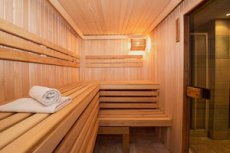Medical expert of the article
New publications
Bath with colds: benefits and harms
Last reviewed: 04.07.2025

All iLive content is medically reviewed or fact checked to ensure as much factual accuracy as possible.
We have strict sourcing guidelines and only link to reputable media sites, academic research institutions and, whenever possible, medically peer reviewed studies. Note that the numbers in parentheses ([1], [2], etc.) are clickable links to these studies.
If you feel that any of our content is inaccurate, out-of-date, or otherwise questionable, please select it and press Ctrl + Enter.

How do we usually start treating a cold? Do we go to a bathhouse? No, we drink as much liquid as possible – hot tea with lemon and honey, raspberry leaf and linden blossom decoction – to sweat properly. So maybe, considering the last factor, it’s worth starting cold treatment in a bathhouse?
The development of acute respiratory diseases (ARI or ARVI), which are commonly called colds, is provoked by various viruses that enter our body - the mucous membranes of the upper respiratory tract. By binding to the receptors of the cells of the mucous epithelium, viruses penetrate their cytoplasm, where they begin to multiply. The reaction to this invasion, initiated by the body's immunocompetent cells, leads to all those symptoms that we fight, including drinking cold teas, steaming our feet, putting mustard plasters, putting drops in our noses, etc.
Is it possible to go to the bathhouse if you have a cold?
Doctors say it is possible, but not for everyone and not always. Some therapists answer the questions: does a sauna help with a cold, and is a sauna useful for a cold? - positively. Others believe that going to a sauna with a cold or flu means exposing your body to unjustified risk. And the necessary hygiene procedures (meaning, washing) should be done at home, for example, in the shower...
The main argument for the benefits of a sauna in treating colds – but only at the very first stage of their development – is the factor of increased sweating: viral toxins leave the body with sweat. Sweat is 99% water and contains very little salt, proteins, carbohydrates, lactic acid and a by-product of protein metabolism – urea. Intensive perspiration – the release of fluid through the skin during sweating – helps the body cleanse itself of metabolic waste and toxins at the cellular level.
But the main function of detoxifying the body is performed by the liver, whose macrophages (Kupffer cells) filter and destroy spent blood cells, bacterial and viral toxins that have entered the bloodstream. And the sweat glands in the skin, according to dermatologists, are not designed to release toxins, and the skin only helps the kidneys in their work.
Sweating is a means of thermoregulation, since the evaporation of sweat from the skin surface produces a cooling effect. We cannot control the process of sweat secretion: it is a physiological reaction that is controlled by the hypothalamus of the brain, where thermosensitive neurons are located, and is regulated by the sympathetic nervous system - through cholinergic neurons that innervate the eccrine sweat glands of the skin.
How can a sauna be useful for a cold?
As is known, there is no need to bring down a temperature that has jumped to +38°C with antipyretic drugs, because with an increase in temperature, the body begins to intensively produce protective proteins of the cytokine class - interferons, which inhibit viral infections and stimulate the entire immune system.
If the cold has not yet led to hyperthermia, and the thermometer readings do not exceed +37°C, when there are no obvious symptoms of malaise, then a bathhouse during a cold can become a heat stress for the body (during bath procedures, the body temperature rises to +38-39°C). Due to this, metabolism increases and blood circulation accelerates with an increase in the volume of blood plasma and an increase in its flow to the heart and muscles.
But the main thing is that artificially increasing the temperature activates the immune system, "switching on" the mechanism of fighting viruses. And inhaling moist heated air - a kind of inhalation in a bathhouse when you have a cold - causes the expansion of blood vessels of the mucous membranes and promotes blood flow to the tissues, and, therefore, an increase in the concentration of protective cells (T- and B-leukocytes, lymphokines, macrophages), which reduce the intensity of virus reproduction.
When is a sauna contraindicated for a cold?
Absolute contraindications to visiting a sauna when you have a cold, which inevitably increases the load on the body, include:
- body temperature above +37°C (fever);
- a state of general weakness;
- headache;
- organic and inflammatory pathologies of the heart;
- aneurysms;
- atherosclerosis;
- arterial hypertension;
- thyrotoxicosis and any thyroid dysfunction;
- anemia;
- pulmonary tuberculosis;
- oncological diseases.
It should be borne in mind that each person's body is individual in terms of reactions to the same irritants. Therefore, it is not surprising that reviews of the effect of visiting a bathhouse when a cold is starting are also different. Many are depressed by the fact that after a bathhouse they feel weak, there are complaints about a sharp deterioration in their condition - rapid heartbeat.
So, you can go to the bathhouse after a cold, and cope with the disease with the help of other folk remedies for colds.

